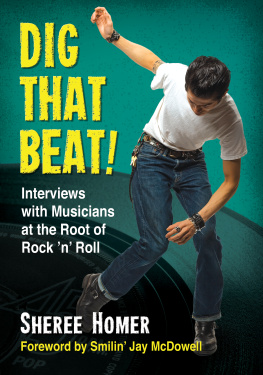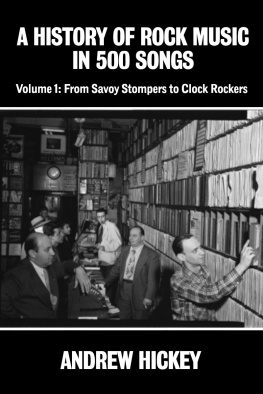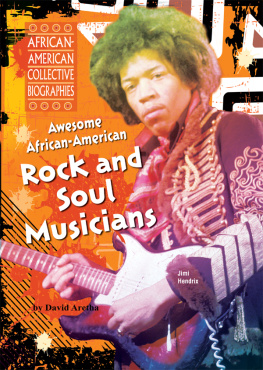This is a Genuine Vireo Book
A Vireo Book | Rare Bird Books
453 South Spring Street, Suite 302
Los Angeles, CA 90013
rarebirdbooks.com
Copyright 2019 by Stephanie Bennett
All rights reserved, including the right to reproduce this book or portions thereof in any form whatsoever, including but not limited to print, audio, and electronic.
For more information, address:
A Vireo Book | Rare Bird Books Subsidiary Rights Department
453 South Spring Street, Suite 302
Los Angeles, CA 90013
Set in Minion
epub isbn : 9781644280553
Publishers Cataloging-in-Publication Data
Names: Bennett, Stephanie, author.
Title: Johnny B Bad: The Making of the Movie Chuck Berry Hail! Hail! Rock N Roll / Stephanie Bennett.
Description: First Hardcover Original Edition | A Genuine Vireo Book | New York; NY; Los Angeles, CA: Rare Bird Books, 2019.
Identifiers: ISBN 9781947856905
Subjects: LCSH Berry, Chuck. | Chuck Berry Hail! Hail! Rock N Roll (Motion picture) | Documentary filmsUnited StatesHistory and criticism. | Musicians in motion pictures. | Concert filmsHistory and criticism. | Rock filmsHistory and criticism. |
BISAC PERFORMING ARTS / Film / Genres / Documentary | PERFORMING ARTS / Film / History & Criticism
Classification: LCC PN1995.9.D6 .B3855 2019 | DDC 780.26/7dc23
To Jane Rose, Suzie Petersen, and Jane Ayer.
For whose courage and support, I will be forever grateful.
Featured Players
Stephanie Bennett Producer
Taylor Hackford Director
Thomas D. Adelman Line Producer
Keith Richards Musical Director
Robbie Robertson Creative Consultant
Helen Mirren Actress
Albert Spevak Business Affairs
Jim Mervis Producers Partner
Dick Allen Chuck Berrys Former Tour Manager
Jane Ayer Publicity for Universal Pictures
Jane Rose Keith Richards Manager
Michael Frondelli Audio Engineer
Oliver Stapleton Cinematographer
Suzie Petersen Head of MCA/Universal
Chuck Berry Artist
Johnnie Johnson Artist
Steve Jordan Artist
Joey Spampinato Artist
Robert Cray Artist
Bo Diddley Artist
Little Richard Artist
Bruce Springsteen Artist
Contents
Foreword
by Taylor Hackford
I n 1985, I was finishing postproduction on my dance film White Nights , starring Mikhail Baryshnikov and Gregory Hines, when I got a call from an English producer, Stephanie Bennett, asking if Id be interested in making a documentary to commemorate Chuck Berrys sixtieth birthday. Being a child of rock n roll whod experienced the blossoming of this All-American artform in the fifties and sixties, this was an opportunity I had to take seriouslythere was no one like Chuck Berryhe was the gold standardthe greatest singer, songwriter, and guitarist of his generation.
I met with Stephanie and found her to be an interesting blend of middle-class English professionalism and ducker and diver entrepreneurship. In addition to having produced docs on The Everly Brothers and The Beach Boys, she had accomplished the seemingly impossible task of securing the rights to The Compleat Beatles , one of the first and best documentaries on The Beatles. I asked her what commitments she already had in place, and she said that Universal Home Video was interested in financing a star-studded concert film featuring major rock n roll artists who had been influenced by Chucks songs and musical style. Basically, that included everyone in rock n roll. The only artist shed already locked-up was Keith Richards, as musical director of this concert. Being a Rolling Stones fan, this pleased me immensely, because I knew there would be a high musical quotient to any concert Keith was involved inplus hed always made it known that his number-one influence was Chuck Berry. Then I asked the most important question: Was Chuck onboard. Stephanie blinked: Chuck says hes in if the price is right, and Universal is ready to pay him handsomely for his musical and personal rights. Of course, I knew what that meant: Stephanie and whoever joined her as director were in for a bumpy ride. I was familiar with the myriad stories about Chucks bad boy personahed already served three stints in prison (for grand-theft auto, sex-trafficking, and tax evasion), and was notorious for demanding cash up-front before hed play a gigoften changing the terms in the process. However, instead of these warning signs deterring me, they were major attractions because I knew that any film featuring Chuck Berry could not be boring. (One problem I have with celebratory documentaries is that they are too often gooey valentines, glossing over the personality flaws that often go hand in glove with an artists ascent to fame and fortune.) With Chuck Berry, I knew it would be impossible to hide his dark undersidethe camera doesnt lie, so if I could capture him candidly in actionI was sure Id make a provocative film. Little did I know how accurate my prediction would turn out to be.
I told Stephanie what Id need to direct this film: total artistic control, including final cut. She immediately agreed. I also said that I was not interested in simply making a concert filmI wanted to capture a candid portrait of Chuck as he interreacted with all the guest artists hed be rehearsing with before the concert, and also I wanted Chuck to agree to speak with me on-camera about his complicated career. Stephanie liked my concepts and said that shed get Universal to approve my deal points. However, as for Chuck agreeing to speak with me on-camera, I would have to convince him myselfChuck was the executive producer of the film.
The first step in putting this project together was for all of us to meet with Chuck to make sure we were all on the same page, so Stephanie, her line producer, Thomas Adelman, Keith, and I flew to Chicago where he was performing at the Chicago Blues Festival. This experience turned out to be prescient in defining the anarchic nature of what this project would become. We met Chuck backstage at the festival, before he was about to go onstage. Being a hustling producer, Stephanie had encouraged the promoter to have photographers present to capture Keith and Chuck togetherhoping this would encourage both men to commit publicly to our film. It was interesting to watch Stephanie workshe boldly suggested to the promoter that he invite Keith on stage at the end of Chucks set for an impromptu jam. Chuck eyed Stephanie coldly, but he didnt object, nodding his approval. At the end of Chucks set, Keith walked out on stage, and the audience went insane, giving the Rolling Stone an ovation that dwarfed what they had given Chuck earlier. I watched Chucks reaction, ever the showman he welcomed Keith with open arms, but I also detected a veiled resentmenta clear slap in the face that this second generation rock n roller was a much bigger star than he was. Keith righteously put the audience in their place: I stole every lick this man ever created, hes the best ever. (Later, Keith told me that the last time theyd met, Chuck had punched him in the face, mistaking him for a troublesome fan. While Keith was good-natured about this insult, I could tell he was still sensitive about the incident. At that moment, I saw what the theme of this film should be: creator versus pupil. Keith, the pupil, who had risen to greater heights of fame and fortune than his mentor, Chuck, who had actually invented the art form.









